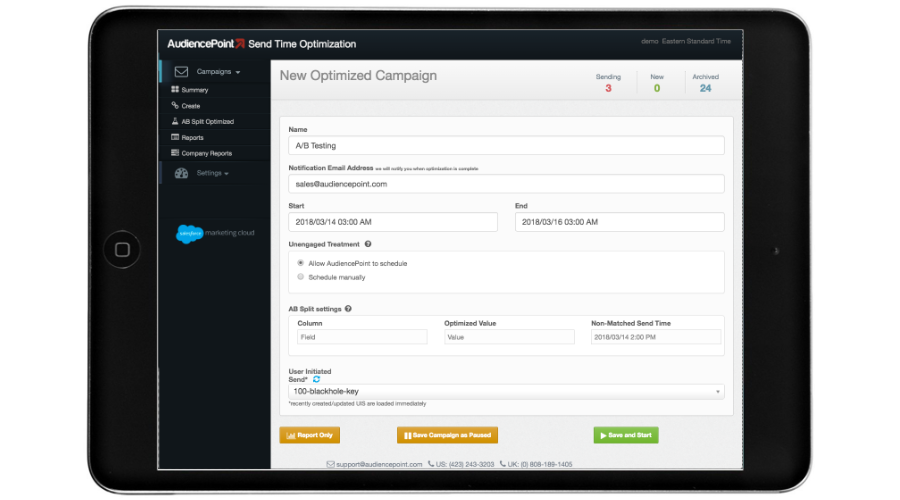AudiencePoint is thrilled to announce our new integration with Klaviyo! AudiencePoint is looking for partners to pilot our...
When tracking email marketing metrics, inbox placement rate is a statistic you should be concerned about. However, many marketers wonder how to track inbox placement and how it can be used as part of their overall email strategy.
This article will outline everything you should know about inbox placement, how it can be tracked, and email address verification tools that can help. Read on for all the details.
What Does Inbox Placement Mean?
Email inbox placement measures how many emails land in subscribers’ primary inboxes out of the total number of emails that were delivered.
It’s an important metric that can be used to differentiate delivered emails between those that land in primary inboxes and those that land in spam folders. As you’ll see in the following section, it’s essential to avoid landing in spam due to many negative long-lasting effects that it can have on your email marketing efforts.
Why Is Inbox Placement Important?
Inbox placement is important because it has a significant impact on engagement rates. Particularly, you want to avoid having your email content landing in spam folders whenever possible because it can lead to many long-term negative effects.
Once you get lots of spam complaints, it’s easy to have a snowball effect where engagement keeps dropping. Even subscribers who didn’t report your content as spam may start having the content you send them to land in spam folders because of the lowered trust scores you have with inbox providers.
What Is the Difference Between Inbox Placement and Deliverability?
Inbox placement is a sub-category of deliverability. So while they’re related, there is a difference between the two. The defining factor is that deliverability is a metric that’s focused on identifying email bounces, whereas placement is more focused on identifying how often content lands in spam folders.
While the deliverability metric is very useful, its one downfall is it doesn’t tell you where your content ends up after it’s delivered. For example, an email that lands in a subscriber’s spam folder still counts as “delivered” within this metric. So while that email didn’t bounce, it still had a negative impact on your email marketing efforts.
That’s where placement comes in to help out. Email placement tells you how many emails out of the ones that were delivered actually made it to primary inboxes. It helps email marketers make more refined optimizations to their strategy to account for placement factors.
What Affects Inbox Placement?
Several factors can impact inbox placement rates. Let’s take a look at some of the main ones.
1. Engagement Rates
How your subscribers engage with content is a big factor in how your emails are placed. For instance, if you’re offering a lot of value in your content and subscribers consistently open it, click links, and get lots of value, you’re more likely to have better placement rates.
If your placement rate is low, reviewing your content quality and trying to find ways to boost engagement rates should be one of your first steps.
2. Email List Quality
When you’re building your email list, you want to do so in the right ways. Using solutions like email address verification tools and double opt-ins will help ensure you build a list full of active subscribers who really want to read content from you.
If you don’t take these measures and don’t re-verify or re-activate subscribers as they become unengaged later on, it can lead to many negative impacts on placement and deliverability. Your content will start bouncing more, and it’ll send many negative signals to inbox providers that will show signs of spam.
3. Spam Complaints
Poor performance on the two previous points and several other factors (like it being hard for subscribers to unsubscribe) can lead to an influx of spam complaints.
On the surface, spam complaints hurt placement rates because your emails will land in spam for subscribers who report them as spam.
Additionally, it once again lowers your trust scores with inbox providers, so a high number of spam complaints can even hurt your placement with subscribers who didn’t report your emails as spam.
Overall, it’s important to take measures ahead of time to avoid all of these negative impacts.
What Is an Acceptable Email Delivery Rate?
Email marketing statistics show that the average email deliverability rate across industries is around 80%. That would generally be considered an acceptable delivery rate. However, you can and should shoot for something that’s better than acceptable to get the best results. 95%+ is a good number to aim for on your email campaigns.
How Do I Monitor My Inbox Placement?
The best way to monitor inbox placement would be using inbox placement tools that focus specifically on placement, or better yet, an insight software that accounts for placement as part of its overall metrics, tracking, and recommendations to help you succeed with email marketing. For the latter option, AudiencePoint’s email insight software is an excellent solution. Most inbox placement solutions rely on only on seedlists whereas AudiencePoint can give you real insights about how your emails are being placed in your subscribers’ inbox.
How AudiencePoint Can Help
AudiencePoint’s email insight software tracks data about how email subscribers engage with content and provides actionable insights about how you can improve your campaigns.
One of the aspects AudiencePoint can help with is inbox placement and deliverability. Our tool ListFit can help track how emails are being placed and the activity of individual subscribers to give you a unique perspective. You’ll know exactly which subscribers need to be re-engaged or any dormant emails that should be removed from your list to improve deliverability rates.
On top of that, AudiencePoint can help you improve placement even further by helping you boost engagement. Our tools can help you with aspects like email segmentation, send time optimization, and real-time insights to plan new and more effective strategies ahead of time.
When your subscribers are more engaged, you’ll naturally be placed in primary inboxes more often, making AudiencePoint an ideal choice to help. Contact us today to learn more.





